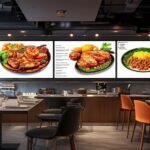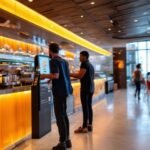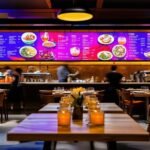Shifting to energy-efficient digital menu boards significantly reduces operational costs and your carbon footprint. By incorporating LED and OLED screens, you’ll only spend less than $20.00 per year on electricity. Digital boards eliminate the necessity for over 4 million printed menus annually in the US, aligning your business with sustainability goals. Many components are recyclable, supporting responsible e-waste disposal. You can instantly update menus, promote environmentally friendly options, and enhance customer engagement with high-definition visuals. By optimizing content management and integrating branding, you’ll create a unified dining experience. Explore how these menu boards benefit your business and contribute to a more environmentally friendly future.
Key Takeaways
- Digital menu boards save over 4,000,000 printed menus annually in the US.
- They use energy-efficient LED and OLED screens with operating costs under $20.00 per year.
- Instant updates reduce the need for physical materials, lowering the carbon footprint.
- Components are recyclable, and manufacturers offer take-back programs to minimize electronic waste.
- Promote sustainable dining choices with real-time updates and high-resolution visuals.
Cutting Down on Paper
By transitioning to digital menu boards, restaurants can save over 4,000,000 printed menus annually in the United States. This significant reduction is a result of eliminating the constant need to print and dispose of paper menus. Digital menu boards offer an efficient, sustainable alternative that allows for instant updates without the need for physical materials.
When you adopt digital menu boards, you can instantly update menu items, prices, and promotions, thereby reducing the environmental impact associated with paper production and waste management. The reduction in paper menus directly translates to a lower carbon footprint. Fewer trees are cut down, and less energy is expended in the production and recycling processes of paper products.
Digital menu boards contribute to a more sustainable environment by minimizing the reliance on paper-based materials. With the restaurant industry being a significant consumer of paper, the shift to digital menu boards is an essential step toward sustainability. By implementing this technology, you not only streamline your operations but also play a part in preserving natural resources and reducing waste. Ultimately, digital menu boards are a forward-thinking solution that aligns with the growing emphasis on environmental responsibility in the industry.
Energy Efficiency and Costs
While digital menu boards reduce paper waste, they also offer impressive energy efficiency and cost savings through modern advancements in technology. Modern digital menu boards are equipped with features like light sensors that adjust brightness based on ambient light levels, significantly cutting down on energy consumption. The integration of LED and OLED screens further enhances their energy-efficient profile, making them a cost-effective option for long-term use.
Operating a digital menu board costs less than $20.00 per year in electricity, demonstrating their minimal impact on your utility bills. This is a stark contrast to the ongoing expenses associated with printing and distributing paper menus. By switching to digital menu boards, you can take advantage of several key benefits:
- Reduced Carbon Footprint: Eliminating the need for over 4,000,000 printed menus annually in the United States.
- Lower Energy Costs: Leveraging energy-efficient technologies like LED and OLED screens.
- Sustainable Operation: Utilizing light sensors to optimize energy consumption based on real-time conditions.
These advancements not only contribute to operational cost savings but also align with broader sustainability goals. By investing in energy-efficient digital menu boards, you’re making a smart, eco-friendly choice that benefits both your business and the environment.
Responsible Recycling
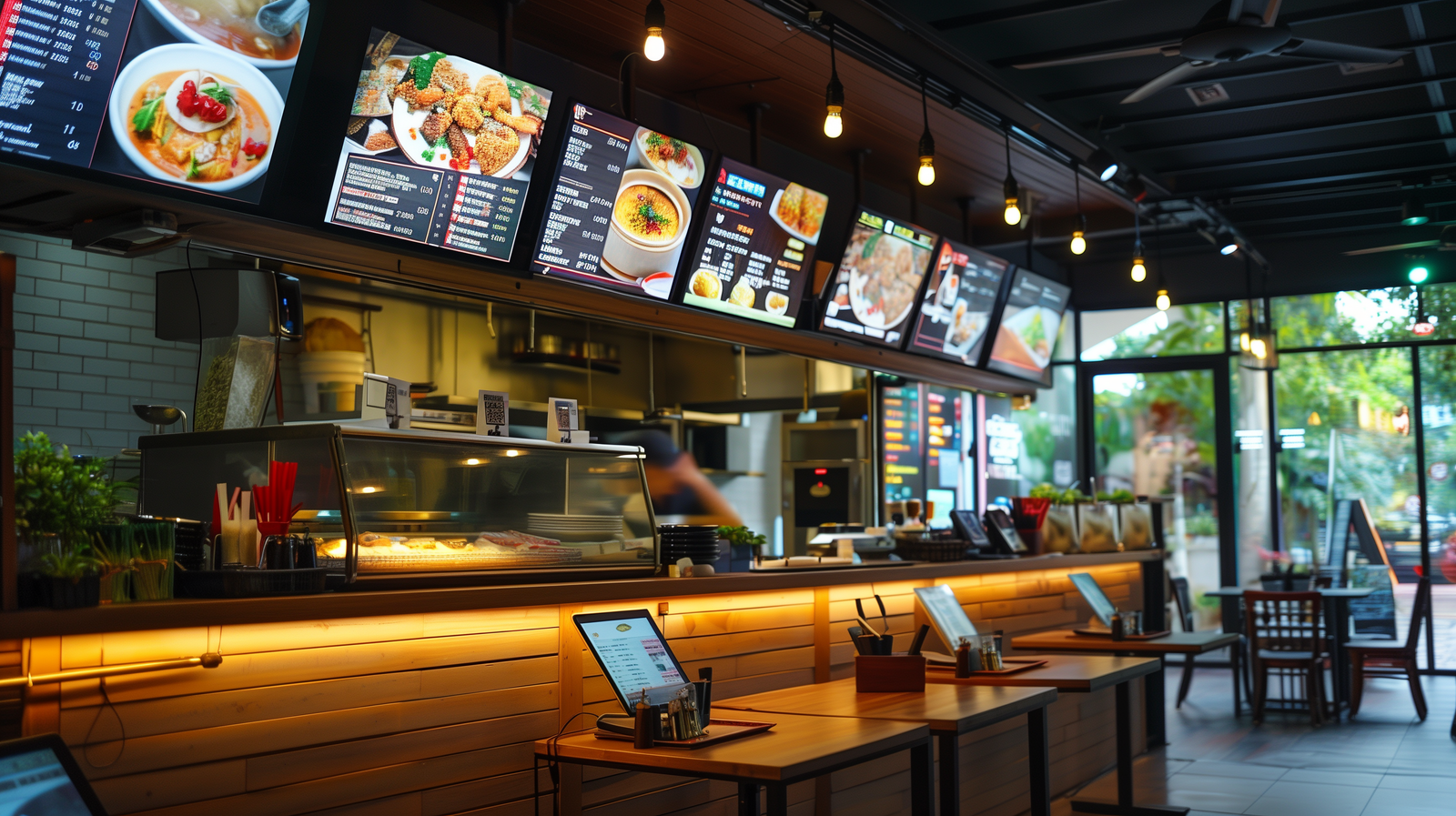
When considering the end-of-life phase for digital menu boards, you’ll find that many components are recyclable, aligning with responsible disposal practices. Numerous manufacturers provide take-back programs, ensuring old units are properly processed and recycled. This approach not only minimizes electronic waste but also supports a sustainable model for the restaurant industry.
Recyclable Board Components
Digital menu boards are designed with recyclable components, ensuring that their disposal minimizes environmental impact. The menu boards’ construction materials, including metals, plastics, and glass, can be efficiently recycled. By focusing on recyclable board components, manufacturers help reduce electronic waste in landfills, aligning with responsible recycling practices.
To effectively manage the lifecycle and disposal of digital menu boards, consider the following recyclable components:
- Metal Frames and Casings: These are often made from aluminum or steel, which can be melted down and reused in various industries.
- Glass Screens: The glass used in the screens can be recycled into new glass products, reducing the need for raw materials.
- Plastic Components: Recyclable plastics, such as those used in housings and connectors, can be processed into new plastic materials, aiding in waste reduction.
Take-Back Programs
Many manufacturers now offer take-back programs for digital menu boards, guaranteeing responsible recycling and reducing electronic waste. These programs are designed to handle the proper disposal and recycling of digital displays, which greatly lessens their environmental impact. By participating in these initiatives, you contribute to sustainable practices and help decrease the volume of electronic waste ending up in landfills.
Digital menu boards are primarily composed of recyclable materials, making them a wise choice for eco-conscious businesses. When you utilize a take-back program, the energy-intensive components are either repurposed or safely disposed of, reducing the overall environmental footprint. This responsible recycling process aligns with sustainability goals and ensures that harmful substances don’t contaminate the environment.
The lifecycle costs of digital menu boards are favorable compared to traditional paper menus. While the initial investment might be higher, the long-term benefits, including lower energy consumption and reduced waste, make them an economically and environmentally sound option. Take-back programs, thus, not only support sustainability but also enhance the overall efficiency and cost-effectiveness of your digital menu board strategy.
Promoting Sustainable Choices

Digital menu boards can highlight eco-friendly options, showcase seasonal and local dishes, and encourage plant-based meals. By dynamically displaying these choices, you influence customers’ decisions and promote sustainable eating habits. This not only enhances customer engagement but also aligns with broader sustainability goals.
Highlight Eco-Friendly Options
By leveraging dynamic displays, you can effectively highlight seasonal and plant-based dishes to promote eco-friendly dining choices. Digital displays allow you to spotlight menu items that align with sustainable practices, encouraging patrons to make environmentally conscious decisions.
To successfully promote eco-friendly options, consider these strategies:
- Real-time Updates: Digital menu boards enable you to swiftly update offerings, ensuring the freshest and most sustainable ingredients are always highlighted.
- Visual Appeal: Use high-resolution images and engaging content to draw attention to eco-friendly dishes, making them more attractive to customers.
- Educational Content: Provide information about the benefits of sustainable eating, such as reduced carbon footprint and health advantages, to educate and motivate diners.
Incorporating these elements into your digital menu boards not only supports sustainable dining practices but also enhances customer engagement. By showcasing eco-friendly options prominently, you set the stage for a dining experience that prioritizes the planet. Digital displays serve as an effective tool for promoting these sustainable choices, ensuring that your restaurant remains at the forefront of eco-conscious dining trends.
Seasonal and Local Dishes
Showcasing seasonal and local dishes on your digital menu boards not only enhances the dining experience but also promotes sustainable eating practices. By integrating seasonal dishes and locally sourced produce into your digital menu content, you can notably reduce your carbon footprint. Seasonal items typically require fewer resources for growth and transportation, making them an eco-friendly choice.
Digital menu boards allow you to dynamically update your menu content to reflect the freshest, in-season ingredients. This not only highlights your commitment to sustainability but also keeps your offerings fresh and engaging. Utilize high-resolution images and engaging descriptions to draw attention to these eco-conscious options, thereby increasing customer awareness and encouraging sustainable dining decisions.
Leveraging digital menu content to feature local and seasonal dishes can also drive customer engagement. Visually appealing displays and dynamic updates can influence consumer behavior, making patrons more inclined to choose environmentally responsible meals. By promoting local and seasonal dishes, you support local farmers and reduce the environmental impact associated with long-distance food transport.
Incorporate compelling, eco-friendly narratives into your digital menu content to further emphasize the benefits of sustainable choices, thereby fostering a culture of responsible dining.
Encourage Plant-Based Meals
Encouraging plant-based meals on your digital menu boards can greatly promote sustainable dining practices and reduce your restaurant’s environmental impact. By leveraging dynamic displays, you can effectively highlight eco-friendly options and influence patrons to make greener choices.
Outdoor Digital Signage Displays are particularly effective in capturing the attention of passersby and enticing them with visually appealing plant-based dishes. Dynamic displays allow you to rotate through various plant-based meals, showcasing their benefits and ingredients in a compelling way. This not only aligns with sustainability goals but also educates your customers on the environmental advantages of choosing plant-based options.
Here are three ways to utilize digital menu boards for promoting plant-based meals:
- Highlight Nutritional Benefits: Use dynamic displays to showcase the health benefits of plant-based meals, such as higher fiber content and lower cholesterol levels.
- Feature Local Ingredients: Emphasize the use of locally sourced, seasonal produce in your plant-based dishes, reducing the carbon footprint associated with transportation.
- Visual Appeal: Use high-resolution images and videos to make plant-based meals look as enticing as possible, encouraging customers to try these sustainable options.
Overall Benefits for Restaurants

Digital menu boards offer restaurants a multifaceted solution that enhances operational efficiency, reduces costs, and promotes environmental sustainability. By integrating outdoor digital signage displays, you streamline content management, allowing for quick updates and real-time promotions. These boards drastically cut down on paper usage, with over 4,000,000 printed menus saved annually in the United States, contributing to substantial environmental benefits.
Energy-efficient features like LED lighting and light sensors lower electricity costs to less than $20.00 per board per year. This significant reduction in energy consumption not only saves money but also aligns with broader sustainability goals. The recyclable components of digital menu boards further promote responsible recycling practices, minimizing waste and supporting eco-friendly initiatives.
Digital menu boards also offer a platform to highlight seasonal dishes and sustainable choices, influencing customer decisions towards eco-friendly options. This capability allows you to promote a green image, attracting environmentally-conscious diners. Overall, digital menu boards are a cost-effective, practical solution that enhances your restaurant’s operational efficiency while supporting sustainability. The combination of reduced paper waste, energy savings, and recyclable components makes digital menu boards an invaluable asset for modern restaurants.
Drive Thru Digital Menu Boards
Drive-thru digital menu boards withstand harsh weather conditions with durable, high-visibility display screens, guaranteeing clear readability for customers in all environments. These Outdoor Digital Signage Displays are engineered to endure extreme temperatures, rain, and direct sunlight, maintaining their clarity and functionality across diverse weather conditions. Their vibrant displays and wide viewing angles enhance the drive-thru experience, making it easier for customers to read and select their orders quickly.
Utilizing drive-thru digital menu boards offers several advantages:
- Efficiency: Real-time updates streamline menu changes and promotions, guaranteeing consistency across multiple locations.
- Sales Increase: Dynamic content can highlight new items or promotions, encouraging upselling and increasing average order value.
- Resource Savings: Automated systems reduce the need for manual updates and maintenance, saving time and labor costs.
Professional installation and remote monitoring services ensure these systems are always performing at their best. Regular maintenance services further contribute to the longevity and reliability of your digital signage. By investing in these advanced menu boards, you boost your operational efficiency and enhance customer satisfaction, creating a seamless drive-thru experience that stands out in the competitive fast-food industry.
Customization and Design
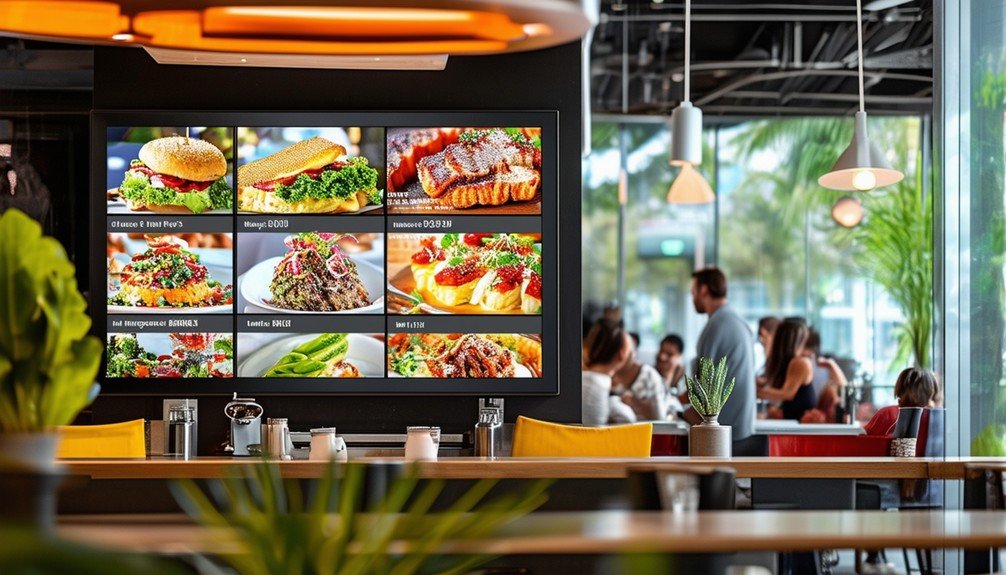
Tailor your digital menu boards with branding integration and interactive features to enhance customer engagement and reflect your restaurant’s unique aesthetic. Customization options allow you to infuse your brand’s identity directly into the boards, guaranteeing a cohesive visual experience for your customers. This can include your logo, color schemes, and specific design elements that align with your restaurant’s overall decor and ambiance.
Incorporating interactive features engages customers in a more dynamic way. Consider adding touchscreens for easy navigation through your menu or promotional content, creating an immersive experience. For outdoor digital boards, weather-resistant designs and high-brightness screens assure visibility and durability, even in varied weather conditions.
Leveraging menu design services can transform your digital boards into visually stunning displays. These services can highlight your menu items and promotions effectively, using high-resolution imagery and strategic layout planning. This approach not only attracts customers but also retains their attention, encouraging repeat visits.
Installation and Maintenance
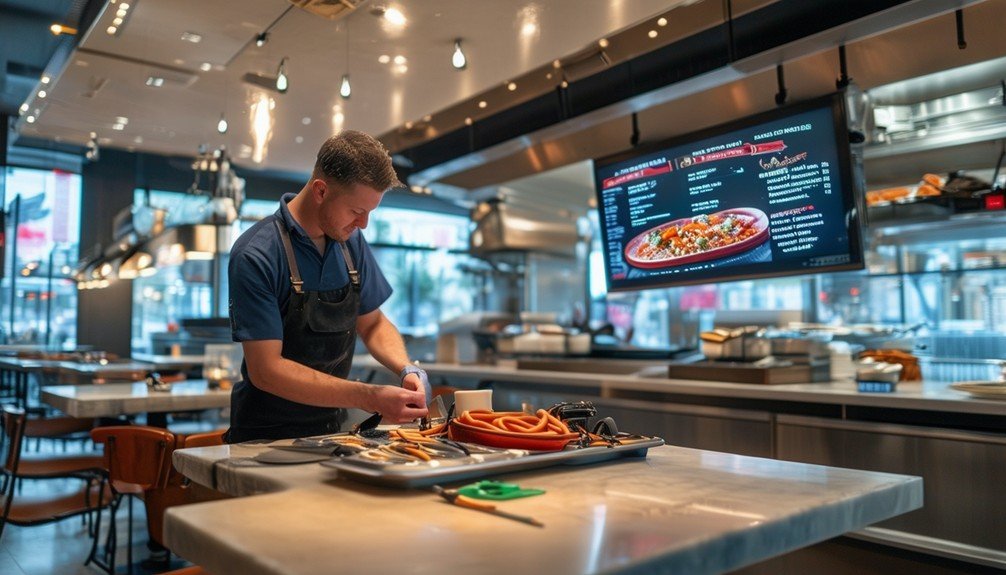
Expert installation services are crucial for your digital menu boards. They ensure a seamless setup and ongoing performance. Proper installation also guarantees your signage displays are configured correctly, preventing future issues. For outdoor displays, professional services secure weatherproofing and peak visibility.
Remote monitoring capabilities allow for easy troubleshooting and maintenance from a distance. You can identify and resolve issues quickly without needing on-site visits, minimizing downtime. Regular maintenance schedules are essential to keep your digital menu boards operating at peak performance and extending their longevity.
To ensure your signage displays remain in top condition, consider the following:
- Remote Monitoring: This enables real-time diagnostics, allowing for prompt troubleshooting and issue resolution.
- Technical Support: Professional support services provide immediate assistance for any queries or problems, securing uninterrupted operation.
- Regular Maintenance: Scheduled checks and updates help maintain peak performance and prevent potential failures.
Troubleshooting assistance is available to address any technical problems that may arise swiftly. By investing in professional installation and maintenance, you ensure your digital menu boards operate efficiently and effectively, providing a consistent and reliable user experience.
Conclusion
By embracing energy-efficient digital menu boards, you’re not just cutting down on paper; you’re also slashing energy costs and promoting responsible recycling. These smart boards empower you to make sustainable choices, providing a greener path for your business. With customizable designs and straightforward installation, they offer a smooth shift for any restaurant. Imagine your drive-thru glowing with innovation, reducing waste, and enhancing customer experience—all while keeping maintenance a breeze!
Frequently Asked Questions
What Is a Dynamic Menu Board?
Imagine a digital billboard in a jiffy! A dynamic menu board is a digital display, updated in real-time, using LED lighting, customizable layouts, and high-quality images to enhance visual appeal and improve customer experience.
Do Digital Menu Boards Increase Sales?
Yes, digital menu boards increase sales by 5-8% on average. You can leverage dynamic displays and real-time updates to drive impulse purchases, upsell, and cross-sell, ultimately enhancing customer decision-making and boosting overall sales performance.
What Is a Static Menu Board?
Think of a static menu board as a snapshot in time. It’s a non-digital display with fixed items and prices, requiring manual updates. This rigidity leads to higher costs, waste, and potentially outdated information for customers.


